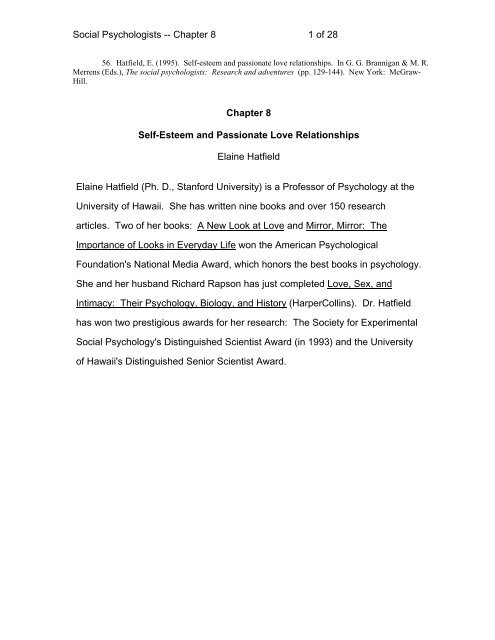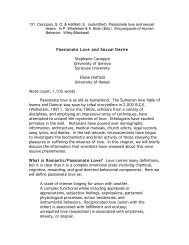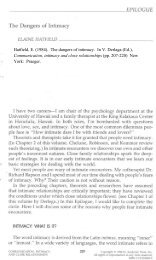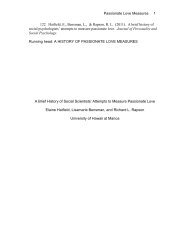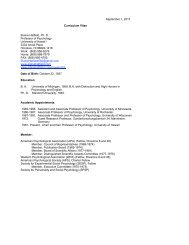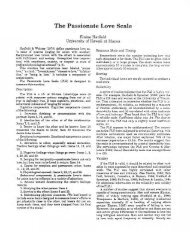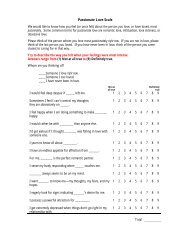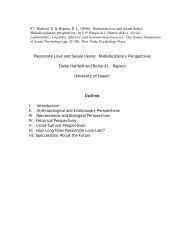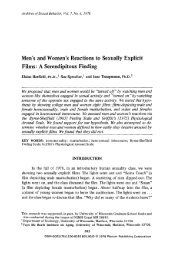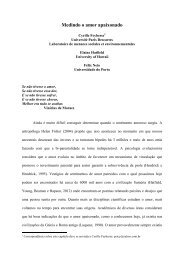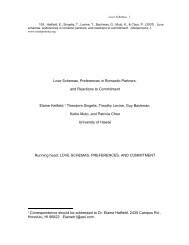Self-esteem and passionate love relationships. - Elaine Hatfield
Self-esteem and passionate love relationships. - Elaine Hatfield
Self-esteem and passionate love relationships. - Elaine Hatfield
Create successful ePaper yourself
Turn your PDF publications into a flip-book with our unique Google optimized e-Paper software.
Social Psychologists -- Chapter 8 1 of 2856. <strong>Hatfield</strong>, E. (1995). <strong>Self</strong>-<strong>esteem</strong> <strong>and</strong> <strong>passionate</strong> <strong>love</strong> <strong>relationships</strong>. In G. G. Brannigan & M. R.Merrens (Eds.), The social psychologists: Research <strong>and</strong> adventures (pp. 129-144). New York: McGraw-Hill.Chapter 8<strong>Self</strong>-Esteem <strong>and</strong> Passionate Love Relationships<strong>Elaine</strong> <strong>Hatfield</strong><strong>Elaine</strong> <strong>Hatfield</strong> (Ph. D., Stanford University) is a Professor of Psychology at theUniversity of Hawaii. She has written nine books <strong>and</strong> over 150 researcharticles. Two of her books: A New Look at Love <strong>and</strong> Mirror, Mirror: TheImportance of Looks in Everyday Life won the American PsychologicalFoundation's National Media Award, which honors the best books in psychology.She <strong>and</strong> her husb<strong>and</strong> Richard Rapson has just completed Love, Sex, <strong>and</strong>Intimacy: Their Psychology, Biology, <strong>and</strong> History (HarperCollins). Dr. <strong>Hatfield</strong>has won two prestigious awards for her research: The Society for ExperimentalSocial Psychology's Distinguished Scientist Award (in 1993) <strong>and</strong> the Universityof Hawaii's Distinguished Senior Scientist Award.
Social Psychologists -- Chapter 8 2 of 28Serious, rigorous research into the nature of <strong>love</strong> barely existed when Ibegan my studies. Today one can barely escape it.The Enthusiastic BeginningsWhen I arrived at Stanford in 1959, I signed up to work with DouglasLawrence <strong>and</strong> Leon Festinger, who were collaborating on a monograph dealingwith "cognitive dissonance in rats." At the University of Michigan, where I hadjust received my B. A., I had worked with Arthur Melton <strong>and</strong> David Birch, botheminent learning theorists. I spent evenings in their laboratories, coaxing ratsover hurdles. So it was natural for me to fall in with Stanford's rigorousexperimentalists <strong>and</strong> mathematical modelers. I was also right at home with rats!There was one problem with this natural alliance, however. I wasfascinated by emotions, in general, <strong>and</strong> the phenomenon of <strong>passionate</strong> <strong>love</strong>, inparticular. One couldn't really be paying attention without noticing that thebehavioral theories seemed to be lacking something when it came to explainingpowerful emotional experiences. It was obvious to me that <strong>passionate</strong> <strong>love</strong> wasa desperately intense motivator. When my friends were besotted with <strong>love</strong>, theywere always a little bit nuts. One male friend could painstakingly articulate why acertain <strong>love</strong>ly, bright, vivacious but extremely neurotic woman was poison <strong>and</strong>why he should stay well away from her. Nonetheless, in spite of his piercinglogic, you couldn't help but notice that he kept one eye on the laboratory phone,waiting for it to become free so that he could call her to plead for "just one morechance." (Nobody seemed to be desperately in <strong>love</strong> with the perfectly sensiblemen <strong>and</strong> women who <strong>love</strong>d them <strong>and</strong> caused no trouble at all.) Clark Hull <strong>and</strong>reinforcement theory simply did not do a very good job of explaining such weird(<strong>and</strong> totally human) behavior. Nor could I discount <strong>passionate</strong> <strong>love</strong> as anunimportant topic. Late in the evenings after our work was done, faculty <strong>and</strong>
Social Psychologists -- Chapter 8 3 of 28students often confided in one another about our personal problems -- all ofwhich seemed to focus on <strong>love</strong>. For most of us, things were not going well;sometimes they were not going at all! Some of us couldn't find anyone to date.Most were in complicated, confusing <strong>relationships</strong>. A few of my friends weregetting divorces. One night several of my friends complained that they were sodiscouraged that they sometimes thought about committing suicide.I began to think about conducting research into <strong>passionate</strong> <strong>love</strong>. Myfellow graduate students, who were mostly hard scientists interested inconstructing mathematical models of rat learning, warned me to avoid suchtopics. They cautioned me that I had to worry about "career management."Passionate <strong>love</strong> just wasn't a very important phenomenon (!) <strong>and</strong> there was nohope of finding out very much about it in our lifetime. Worst of all, the wholetopic just wasn't respectable. And it wasn't "hot." The topic of the moment wasmathematical modeling. Reinforcement theory <strong>and</strong> math modeling. One set ofinterests (reinforcement <strong>and</strong> math models) during the daytime <strong>and</strong> another(<strong>passionate</strong> <strong>love</strong> <strong>and</strong> maybe suicide) in the evenings.I was always stubbornly interested in what I was interested in rather thanwith "career management"; so I suggested to Leon Festinger, my advisor, thatour Thursday night research group should set aside some time now <strong>and</strong> then fordiscussing hazy, half-formed ideas. We could discuss the possibilities of doingresearch on taboo, neglected, impossible topics like <strong>love</strong>, sex, <strong>and</strong> the emotions.He said that sounded like a great idea. I should go first. I decided to speculateabout possible links between self-<strong>esteem</strong> <strong>and</strong> one's vulnerability to <strong>love</strong>. My ideawas this:When self-<strong>esteem</strong> tumbled to an all-time low, one should be especiallyvulnerable to falling in <strong>love</strong>. I thought that there were two reasons why this mightbe so.
Social Psychologists -- Chapter 8 4 of 28First, people with high self-<strong>esteem</strong> are likely to assume that they have agreat deal to offer others; they can afford to "dem<strong>and</strong> the very best." Thus, thehigher one's self-<strong>esteem</strong>, the more one might require from a "suitable" date ormate. Second, when self-<strong>esteem</strong> is low or has been momentarily shattered, onemay well have an increased need for the affection <strong>and</strong> regard of others. Thelower one's self-<strong>esteem</strong>, the more appreciative people will be when anyoneseems to <strong>love</strong> them, <strong>and</strong> the more likely they may be to reciprocate thataffection.My first step was to check the clinical literature to see if there was anyresearch to support my hypothesis. There wasn't much. In 1949, Theodor Reikhad published a wise <strong>and</strong> witty book entitled A Psychologist Looks at Love. Heargued that people were most susceptible to <strong>passionate</strong> <strong>love</strong> when their self<strong>esteem</strong>had been bruised. Novelists seconded his observations. MaryMcCarthy, in The Company She Keeps, for example, discussed the linkbetween low self-<strong>esteem</strong> <strong>and</strong> vulnerability to even deeply flawed <strong>love</strong>. Herheroine Margaret Sargent has been enslaved by <strong>love</strong>. In therapy, she made anilluminating discovery:Now for the first time she saw her own extremity, saw that it wassome failure in self-<strong>love</strong> that obligated her to snatch blindly at the<strong>love</strong> of others, hoping to <strong>love</strong> herself through them, borrowing theirfeelings, as the moon borrowed light. She herself was a dead planet.(1942;. 303).But most clinicians (such as Carl Rogers, Alfred Adler, Karen Horney, EricFromm) said Reik (<strong>and</strong> I) had things the wrong way around. It was high self<strong>esteem</strong> people who were most receptive to <strong>love</strong>. They argued, logically enough:if people can't <strong>love</strong> themselves, how can they be expected to <strong>love</strong> anyone else?The sparse correlational data that existed seemed to support their contentions
Social Psychologists -- Chapter 8 5 of 28<strong>and</strong> challenge Reik's (<strong>and</strong> mine). I suspected that Leon Festinger wouldprobably agree with these theorists as well. Dissonance theory would predict thatif we think badly of ourselves, we should experience cognitive dissonance ifsomeone assures us we are wonderful. One likely way to reduce dissonancewould be to assume that these Pollyanna's must be stupid, confused, or haveulterior motives. Surely when they got to know us better they would change theirminds.On Thursday night, as I stood up to present my half-formulated ideas tothe research group, I was stunned to discover that Leon, who had arrived latefrom a merry faculty dinner at a Greek restaurant, had invited some of thecelebrants -- Al Hastorf, Gordon Bower, Jon Freedman, <strong>and</strong> Alex Bavelas -- backto that night's meeting. I plunged on ahead. It is probably unnecessary tomention that my proposal did not knock the socks off the assembled critics.Many of them agreed that the idea just wasn't a very interesting one. One criticnoted that in the l940s, theorists had found that rats on partial learning schedulesdisplayed a burst of energy when a reward finally did arrive. Presumably suchlong-denied rewards were doubly rewarding. The phenomenon even had aname -- the Crespi effect. Why bother replicating a well-established finding yetagain? People or rats, it didn't matter. An effect was an effect. Others cautionedme that people's perceptions as to what was rewarding were elusive. Would wefind someone who confirmed our opinions rewarding? What if others agreed thatwe were miserable human beings? Was even that rewarding? Or did weinevitably prefer those who praised them? Who knew? Why bother? Why notstick to basic research?So, of course, I proceeded to do just what I wanted to do anyway. Iagreed that I would run traditional, sensible, dissonance <strong>and</strong> learning
Social Psychologists -- Chapter 8 6 of 28experiments in the daytime. But I would do my own research in the evenings<strong>and</strong> on weekends.I set out to test the hypothesis that men <strong>and</strong> women would be mostvulnerable to <strong>love</strong> when their self-<strong>esteem</strong> had been momentarily shattered.(Well, not exactly shattered. Maybe slightly threatened. I was very worried thatwe might go too far <strong>and</strong> hurt someone's feelings). I invited 37 StanfordUniversity <strong>and</strong> Foothill Junior College women to take a battery of psychologicaltests -- the California Personality Inventory, the Minnesota MultiphasicPersonality Inventory, <strong>and</strong> the Rorschach test. A week later, the womenreported (one at a time) for further testing <strong>and</strong> interviewing. I arrange to haveGerald Davison, a h<strong>and</strong>some graduate student, waiting for me (theexperimenter). Since I was late, the two of them began to chat. The time <strong>and</strong>conversation stretched out. Eventually Jerry invited the woman to dinner <strong>and</strong> amovie the next weekend. All accepted.Soon, I showed up, breathless, apologizing for being late. I asked Jerryto administer the Word Association test; I said I could administer the Rorschachtest. Jerry read the protocol to the subjects, <strong>and</strong> I sent him on his way. At theend of the session, I asked the women if they were interested in their results.They all were. So I gave bogus feedback, designed momentarily to raise,lower, or leave their self-<strong>esteem</strong> unchanged. If women had been r<strong>and</strong>omlyassigned to the low-<strong>esteem</strong> condition, the analysis stressed their personalityproblems, immaturity, lack of openness, anti-social motives, limited capacity forsuccessful leadership, <strong>and</strong> lack of originality <strong>and</strong> flexibility. If women had beenr<strong>and</strong>omly assigned to the high-<strong>esteem</strong> condition, the report stressed theirpersonality strengths, maturity, warmth <strong>and</strong> openness, integrity, <strong>and</strong> so forth. Itstated that she presented "one of the most favorable personality structuresanalyzed by the staff." Women who had been assigned to the control condition
Social Psychologists -- Chapter 8 7 of 28were told that their tests had not yet been scored. Thus, they received nofeedback.In later interviews, women were asked their first impressions of Jerry <strong>and</strong>a number of other people, including the experimenter. As predicted, it was thewomen whose self-<strong>esteem</strong> had been threatened who were most attracted to him.Women whose self-<strong>esteem</strong> had been boosted liked him alright, just not so much.I worried, of course, about the ethics of this deception experiment. Inextensive posttesting, I interviewed subjects about their feelings. Did they enjoythe experiment? (Earlier that year, Eleanor Maccoby, who was rightlyconcerned about the ethics of social psychological experimentation, had polledStanford undergraduates as to which experiments they liked, which theydisliked; which were ethical, which not. She had been worried that studentswould disapprove of social psychology experiments, since they often involveddeception. To her surprise, she discovered that undergraduates <strong>love</strong>d thesocial psychological experiments. They thought they were fun. What theyhated were the rote-learning experiments. Those long boring lists of pairedassociates. Arrghhhhh.). Thus, I wanted to be sure students enjoyedparticipating in my experiment; I thought it probably was a bit unethical to boresubjects to death!Had subjects' feelings been hurt? If they had known what they weregetting into, would they have agreed to participate? We set aside an hour at theend of the experiment to debrief subjects. We talked about <strong>passionate</strong> <strong>love</strong>, ingeneral, <strong>and</strong> the women's concerns in particular. We replayed the experiment<strong>and</strong> asked if anything about the procedure had bothered them. How could wechange it? Because I was concerned about the ethics of deception research, Idid a great deal of pretesting <strong>and</strong> ended up publishing a monograph on theconsequences of various debriefing strategies.
Social Psychologists -- Chapter 8 8 of 28The Disappointing MiddleOver the next two decades, I team-taught a number of social psychologyresearch courses in which faculty <strong>and</strong> students speculated about the possiblelinks between self-<strong>esteem</strong> <strong>and</strong> <strong>passionate</strong> <strong>and</strong> companionate <strong>love</strong>. A mini-teamof economists (Edgar Feige), statisticians (G. William Walster), <strong>and</strong> computerwhizzes (Susan Sprecher) set out to caste these predictions in precisemathematical terms. Finally, Susan Sprecher (a sociologist), Ellen Berscheid (apsychologist), <strong>and</strong> I decided to investigate the process in a step-by-step fashion.We proposed that self-<strong>esteem</strong> should affect people's reactions to others in anumber of interlocking ways. We conducted five more experiments in an effort totest our hypotheses. The team's theorizing may have been brilliant, but ourresults were not.Let us review this ill-fated research.l. Measuring self-<strong>esteem</strong>. Before embarking on the research it wascritically important to define just what we meant by "self-<strong>esteem</strong>." Essentially, wewere interested in how much self-<strong>esteem</strong> people had concerning their romanticvalue -- i.e., how much confidence they had that they were lovable; someonewho deserved <strong>love</strong> <strong>and</strong> was likely to ignite it. Did they possess a basic trust thattheir <strong>relationships</strong> were likely to go well?We were unable to find any existing self-<strong>esteem</strong> measures that tappedsuch quiet confidence. One of our students Edward Wells set out to review theself-<strong>esteem</strong> literature so that our team could select the best of the existingmeasures. He invested so much thought <strong>and</strong> time in the project that he <strong>and</strong>Gerald Marwell ended up publishing a monograph on the topic: <strong>Self</strong>-<strong>esteem</strong>: ItsConceptualization <strong>and</strong> Measurement. In four studies, we decided to measureself-<strong>esteem</strong> via the measures that seemed closest to the construct in which wewere interested:
Social Psychologists -- Chapter 8 9 of 28l. The Berger Measure of <strong>Self</strong>-<strong>esteem</strong>2. The Rosenberg <strong>Self</strong>-<strong>esteem</strong> Scale3. The California Personality Inventory (This scale includes measures ofpoise, ascendancy, <strong>and</strong> self-assurance (i.e., measures of dominance, capacityfor status, sociability, social presence, self-acceptance, <strong>and</strong> sense of wellbeing.)In addition, in the fifth experiment, we followed the procedure we had employedin our original study. We manipulated rather than measured self-<strong>esteem</strong>. Inthis experiment, then, we were studying the effect of momentary gains or lossesin self-<strong>esteem</strong> on vulnerability to <strong>love</strong>. In the other four experiments we wereexploring the impact of habitually high or low self-<strong>esteem</strong> on vulnerability to<strong>love</strong>. We thought it should make no difference.2. Should we study<strong>passionate</strong> <strong>love</strong>, companionate <strong>love</strong>, or both? Theoretically, self-<strong>esteem</strong> shouldeffect vulnerability to both <strong>passionate</strong> <strong>and</strong> companionate <strong>love</strong>. Passionate <strong>love</strong>(sometimes labeled obsessive <strong>love</strong>, infatuation, <strong>love</strong> sickness, or being in <strong>love</strong>)is an intense emotion. It is defined as:A state of intense longing for union with another. Reciprocated<strong>love</strong> (union with the other) is associated with fulfillment <strong>and</strong>ecstasy. Unrequited <strong>love</strong> (separation) is associated withemptiness, anxiety, or despair. Passionate <strong>love</strong> is a complexfunctional whole including appraisals or appreciations, subjectivefeelings, expressions, patterned physiological processes, actiontendencies, <strong>and</strong> instrumental behaviors. (<strong>Hatfield</strong> & Rapson, l993,p. 5).The Passionate Love Scale was designed to assess the cognitive,physiological, <strong>and</strong> behavioral indicants of such a longing for union.
Social Psychologists -- Chapter 8 10 of 28Companionate <strong>love</strong> (sometimes called true <strong>love</strong> or conjugal <strong>love</strong>) is a farless intense emotion. It combines feelings of deep attachment, commitment,<strong>and</strong> intimacy. It is defined as:The affection we feel for those with whom our lives are deeplyentwined. Companionate <strong>love</strong> is a complex functional wholeincluding appraisals or appreciations, subjective feelings,expressions, patterned physiological processes, action tendencies,<strong>and</strong> instrumental behaviors. (<strong>Hatfield</strong> & Rapson, l993, p. 106).Psychologists have used a variety of scales to measure companionate <strong>love</strong>.For example, Robert Sternberg assumed that such <strong>relationships</strong> possessedlittle passion but a great deal of commitment <strong>and</strong> intimacy; thus, he assessedcompanionate <strong>love</strong> by measuring commitment <strong>and</strong> intimacy. Since we thoughtthreats to self-<strong>esteem</strong> might have the most profound impact on <strong>passionate</strong><strong>love</strong>, <strong>and</strong> a lesser impact on companionate <strong>love</strong>, we decided to maximize ourchances of discovering how the process worked by focusing on buddingromantic <strong>relationships</strong>.3. A step-by-step analysis of the possible effects of self-<strong>esteem</strong> onromantic attraction. Finally, Susan Sprecher <strong>and</strong> I set out to explore the impactof self-<strong>esteem</strong> on romantic perceptions <strong>and</strong> feelings in an orderly way.(a) <strong>Self</strong>-<strong>esteem</strong> <strong>and</strong> perception. First, we proposed that self-<strong>esteem</strong>should shape people's perceptions as to whether or not a potential romanticpartner is attracted to them. In the early stages of a flirtation, it is often difficultfor young men <strong>and</strong> women to assess whether or not someone is interested inthem. We might expect such perceptions to be colored by their own selfevaluations.In one experiment, for example, we studied the men <strong>and</strong> womenwhose self-<strong>esteem</strong> had been raised or lowered. We were interested in theirreactions to potential dates who were accepting, rejecting, or whose feelings
Social Psychologists -- Chapter 8 11 of 28were unclear. We had assumed that all the men <strong>and</strong> women would "correctly"perceive how potential dates felt about them. We discovered that it was not safeto make such an assumption. Even though we had labored to compose crystalclear messages of acceptance or rejection, different subjects interpreted thesemessages in very different ways. For example, after being severely rejected,one man gave a knowing smile <strong>and</strong> commented, "You can always tell when a girlis interested in you -- she plays hard to get." Other subjects had the oppositeproblem. A few managed to interpret even the most enthusiastic ofcommunications as evidencing subtle rejection, pity . . . or if all else failed, theyassumed a case of mistaken identity.Thus, in Hypothesis 1 we proposed that young men's <strong>and</strong> women's self<strong>esteem</strong>would affect their perceptions of how much others liked them.Specifically,Low self-<strong>esteem</strong> individuals will underestimate how muchthey are liked by dates while high self-<strong>esteem</strong> individuals wil<strong>love</strong>restimate how much they are liked. Such distortions will beespecially pronounced when the date's expressions of liking ordisliking for the subject are ambiguous.(b). <strong>Self</strong>-<strong>esteem</strong> <strong>and</strong> liking for others. People's self-<strong>esteem</strong> should alsoaffect their liking for others. For the sake of argument, let us assume that all thesubjects, regardless of their own self-<strong>esteem</strong> level, correctly perceived how muchthey were liked or disliked by others. How might we expect self-<strong>esteem</strong> toinfluence their reactions to a potential date's expressions of affection or hostility.As we observed earlier, self-consistency (dissonance) theory <strong>and</strong> reinforcementtheory would make very different predictions. <strong>Self</strong>-consistency theory assumesthat people will most like others who share their opinions -- for good or for ill.
Social Psychologists -- Chapter 8 12 of 28Reinforcement theorists argue that while everyone should prefer praise to blame,people with low self-<strong>esteem</strong> are more "needy" than their peers, <strong>and</strong> thereforeshould be especially appreciative of those that provided that rare commodity(affection) <strong>and</strong> more resentful of those who withheld it. We, <strong>and</strong> the then existingevidence, favored this latter prediction. Thus, in Hypothesis 2 we proposed:Low self-<strong>esteem</strong> people should be especially attracted tothose they perceive like them <strong>and</strong> especially hostile to those whothey perceive do not.(c) Finally, we attempted to integrate these two predictions. We predictedthat:Low self-<strong>esteem</strong> individuals will have more volatile relationswith others than will high self-<strong>esteem</strong> individuals. Low self-<strong>esteem</strong>individuals should especially like those who like them <strong>and</strong>especially dislike those who do not.Our research team had put so much work into sketching out ourpredictions <strong>and</strong> translating them into a complex theoretical mathematical model,that we were convinced that we just had to be right.We then proceeded to conduct five experiments to test our hypotheses.In the first four of them we began by measuring subjects' stable self-<strong>esteem</strong>.Men <strong>and</strong> women completed one of the self-<strong>esteem</strong> measures we describedearlier -- The California Personality Inventory, the Berger Measure of <strong>Self</strong><strong>esteem</strong>,or the Rosenberg <strong>Self</strong>-<strong>esteem</strong> Scale. Then subjects either talked topotential romantic partners on the telephone, corresponded with them, or metthem for coffee in the University Rathskeller. After the meeting, the subjects <strong>and</strong>the potential romantic partner were sometimes given a chance to relate their firstimpressions of one another. Sometimes the answers were scripted, sometimesnot. In the cases where they were scripted, the positiveness of the bogus
Social Psychologists -- Chapter 8 13 of 28evaluations was systematically varied. In some conditions, O's bogus reportwas totally favorable (For example, Os might say they were "really prettyimpressed" with the subject). Sometimes O's impression was ambiguouslyfavorable (For example, O might say that it was difficult to tell anything from "justthis." Would S be interesting to talk to? "I'd like to talk with him, I think. Whynot?"). Sometimes O's impression was ambiguously negative. Sometimes itwas totally negative. Then we asked subjects either to: (1) assess the potentialdate's real feelings for them; (2) assess how they felt about the potential date; or(3) both.We then conducted extensive statistical tests to determine whether theresults matched our mathematical model. The results were disheartening.First, we had argued that men <strong>and</strong> women whose habitual self-<strong>esteem</strong>was either high or low would differ in their perceptions of how much they wereliked. This hypothesis was not supported. In general, although there were hintsthat self-<strong>esteem</strong> might have a trace of an effect on how messages wereperceived, these effects were too weak to worry about. Contrary to ourexpectations, the biggest determinant of perceptions of how much one was likedwas "reality" -- how much the individual was liked by the other. Scratchhypothesis 1, then.Second, we predicted that men <strong>and</strong> women whose self-<strong>esteem</strong> washabitually high or low would differ in their reactions to expressions of liking ordisliking. This hypothesis also was not supported by the data. Subjects' self<strong>esteem</strong>seemed to have no impact on how much they liked/disliked accepting orrejecting others. Once again, contrary to our expectations, the biggestdeterminant of the subjects' liking for the other seemed to be the other's actualliking for them. The more the other actually liked them, the more subjects likedthem in return.
Social Psychologists -- Chapter 8 14 of 28Stable self-<strong>esteem</strong>, then, seemed to have no impact on how subjectsperceived others' intentions or reacted to them.Interestingly enough, inone study we had studied not stable self-<strong>esteem</strong> but, as in the very firstexperiment we had conducted, had manipulated it. There we did find support forour hypotheses. We interviewed college men at the University of Rochester <strong>and</strong>at Temple University. They were given the MMPI, the Strong Vocational InterestInventory, the Rorschach <strong>and</strong> the TAT. We collected teacher evaluations <strong>and</strong>high school <strong>and</strong> college grades. Some men were given favorable psychologicalreports; others received negative reports. In a telephone conversation, the menhad a chance to hear a woman's first impression of them. When men's self<strong>esteem</strong>had been momentarily raised, they were more likely to interpret awoman's positive or even ambiguous statements of affection as real interest.When men's self-<strong>esteem</strong> had been lowered, they were unusually skeptical of herexpressions of affection. When men's self-<strong>esteem</strong> had been momentary loweredthey were unusually volatile. They liked an affectionate woman more <strong>and</strong> onewhose feelings were ambiguous or negative less than they normally would. Menwhose self-<strong>esteem</strong> had been raised were more temperate in their reactions. Wewere perplexed. People whose self-<strong>esteem</strong> was habitually high or habitually lowdid not seem to differ in their perceptions of or reactions to potential dates.However, when these same men's <strong>and</strong> women's self-<strong>esteem</strong> was momentarilyraised or lowered, they reacted as we expected they would. What was going on?We would not answer this question for several years.The most damaging blow to our research program was yet to come. In1975, Wisconsin's Senator William Proxmire discovered that the NationalScience Foundation had granted Dr. Ellen Berscheid, one of my researchpartners, $84,000 to further her work on <strong>passionate</strong> <strong>and</strong> companionate <strong>love</strong>. Hefired off a press release:
Social Psychologists -- Chapter 8 15 of 28I object to this not only because no one -- not even theNational Science Foundation -- can argue that falling in <strong>love</strong> is ascience; not only because I'm sure that even if they spend $84million or $84 billion they wouldn't get an answer that anyone wouldbelieve. I'm also against it because I don't want the answer.I believe that 200 million other Americans want to leavesome things in life a mystery, <strong>and</strong> right on top of the things we don'twant to know is why a man falls in <strong>love</strong> with a woman <strong>and</strong> viceversa . . . .So National Science Foundation -- get out of the <strong>love</strong> racket.Leave that to Elizabeth Barrett Browning <strong>and</strong> Irving Berlin. Here ifanywhere Alex<strong>and</strong>er Pope was right when he observed, "Ifignorance is bliss, tis folly to be wise."An attack on my research project soon followed. Senator Proxmireawarded both of us the critical "Golden Fleece Award." Subsequently, he gavethe same "Award" to dozens of other <strong>love</strong> <strong>and</strong> sex researchers, supposedly for"fleecing" the government by conducting research that was "junk." Proxmire'sjoke could have been worth a chuckle, except that he was deadly serious. Thepress of course had a field day. My mother's Roman Catholic bishop, the Rt.Rev. Richard S. Emrich, denounced our work in a Detroit newspaper. Hereminded parishioners that Christ had told us all we need to know about <strong>love</strong> inthe Holy Bible. We should just follow His orders. The Chicago Daily Newsbegan a daily series on the debate. They invited readers to call in with theirvotes. Did readers think our <strong>love</strong> research was worth $334,000 in tax money ornot. (That was the amount NSF had granted to various <strong>love</strong> researchers atvarious times.) The answer of course was a resounding "No!" To illustrate therelative st<strong>and</strong>ing of Proxmire <strong>and</strong> <strong>Hatfield</strong> in the informal poll, they showed two
Social Psychologists -- Chapter 8 16 of 28cartoon character's heads -- his <strong>and</strong> mine -- pasted on little cartoon bodies <strong>and</strong>balanced precariously on a teeter-totter. Each day, as irate readers called orwrote in, <strong>Hatfield</strong>'s st<strong>and</strong>ing or sitting (<strong>and</strong> position on the teeter-totter) sanklower <strong>and</strong> lower. The final st<strong>and</strong>ing: Proxmire 8, <strong>Hatfield</strong> l. Conclusion: Loveshould remain a mystery.Senator Barry Goldwater came to my defense. So did columnist JamesReston. In his column in The New York Times he wryly agreed that <strong>love</strong> willalways be a mystery. "But if the sociologists <strong>and</strong> psychologists can get even asuggestion of the answer to our pattern of romantic <strong>love</strong>, marriage, disillusions,divorce -- <strong>and</strong> the children left behind -- it would be the best investment of federalmoney since Jefferson made the Louisiana purchase."I tried to explain why the study of <strong>love</strong> is important. In 1978, I wrote a littlebook (A New Look at Love) to explain why the study of <strong>love</strong> is important <strong>and</strong>what social psychologists have learned about <strong>passionate</strong> <strong>and</strong> companionate<strong>love</strong>. In 1979 the book won the American Psychological Association's <strong>and</strong> theAmerican Psychological Foundation's National Media Award for the best book inpsychology. This year, my husb<strong>and</strong> Richard L. Rapson <strong>and</strong> I updated the bynow voluminous findings on this topic in Love, Sex, <strong>and</strong> Intimacy: TheirPsychology, Biology <strong>and</strong> History.Today, many people assume that the great debate is today an enjoyablememory for me. They make that assumption because the "taboo topics" Ithought were fascinating have been taken up by a generation of youngresearchers. Today, <strong>love</strong> <strong>and</strong> emotion are the "hot topics." But I rememberthose "bad, old days" with no pleasure. The battle, though it had to be fought<strong>and</strong> despite the agreeable outcome, was never fun.The Ending: A Paradigm Shift
Social Psychologists -- Chapter 8 17 of 28In the 1980s, social psychologists began to look at the relationshipbetween self-<strong>esteem</strong> <strong>and</strong> <strong>love</strong> in a new way -- <strong>and</strong> suddenly our "confusing"findings fell into place. Let me provide the background for this surprising shift.Developmental psychologists Mary Ainsworth <strong>and</strong> John Bowlby studied theprocess of attachment, separation, <strong>and</strong> loss in children. Infants normallyprogress through four developmental phases. During the first few months oflife, infants will smile, gurgle, <strong>and</strong> snuggle into almost anyone. At about threemonths of age, the infants begin to notice that their caretaker (usually theirmother) is someone special. They begin to take a special interest in her. Atabout six to nine months, infants normally become deeply attached to theirmothers. They smile, jabber, <strong>and</strong> stretch out their arms to Her; if they areseparated, they protest. No one else will do. When they are frightened,anxious, tired, or sick they cling to their mothers for security. After about nine to12 months, toddlers slowly begin to take an interest in a wider circle of people.Parents <strong>and</strong> infants differ, of course, in personality <strong>and</strong> skill. Infants willdiffer in the degree to which they have learned to rely on the attachment figureas a source of security. Mary Ainsworth <strong>and</strong> her colleagues found that childrenform three kinds of attachments to their caretakers. Most infants are securelyattached. They are comfortable with affection <strong>and</strong> independence. Otherspossess an anxious/resistant attachment. They tend to be anxious <strong>and</strong>uncertain in their interactions with their mothers. They are difficult to comfortafter a brief separation. Some infants develop an avoidant attachment. Theyseem to lack whatever it takes to form close <strong>relationships</strong> with anyone. Theyare unemotional <strong>and</strong> unresponsive.Philip Shaver <strong>and</strong> Cindy Hazan pointed out that romantic <strong>love</strong> is a form ofattachment. Children's early patterns of attachment should be mirrored in the<strong>passionate</strong> attachments they make in adulthood. Men's <strong>and</strong> women's
Social Psychologists -- Chapter 8 18 of 28attachment styles were measured with a single question: Which of the followingbest describes your feelings?Secure: I find it relatively easy to get close to others <strong>and</strong> am comfortabledepending on them <strong>and</strong> having them depend on me. I don't often worry aboutbeing ab<strong>and</strong>oned or about someone getting too close to me.Anxious/ambivalent: I find that others are reluctant to get as close as Iwould like. I often worry that my partner doesn't really <strong>love</strong> me or won't want tostay with me. I want to merge completely with another person, <strong>and</strong> this desiresometimes scares people away.Avoidant: I am somewhat uncomfortable being close to others; I find itdifficult to trust them completely, difficult to allow myself to depend on them. Iam nervous when anyone gets too close, <strong>and</strong> often, <strong>love</strong> partners want me tobe more intimate than I feel comfortable being.Hazan <strong>and</strong> Shaver (1987), p. 515People were asked to endorse one of the three self-descriptions.Shortly thereafter Kim Bartholomew <strong>and</strong> Leonard Horowitz tried toextend the previous model. They too proposed that childhood attachmentsshould serve as prototypes for later attachments. They argued, however, thatadults' attachment styles should fall into one of four patterns, depending on the<strong>love</strong>r's self-image (positive or negative) <strong>and</strong> his or her image of the be<strong>love</strong>d(positive or negative). (1) Men <strong>and</strong> women who have positive self-<strong>esteem</strong> (theself is worthy of <strong>love</strong> <strong>and</strong> support) <strong>and</strong> a positive image of dates <strong>and</strong> mates(other people are seen as trustworthy <strong>and</strong> available) should find it easy tobecome securely attached to others. (2) Those with low self-<strong>esteem</strong> (they arenot worthy of <strong>love</strong> or support) <strong>and</strong> a positive regard for others should beanxious/ambivalent about falling in <strong>love</strong>; they should be preoccupied orenmeshed with those they <strong>love</strong>. (3) Those who have a negative self-image <strong>and</strong>
Social Psychologists -- Chapter 8 19 of 28a negative image of others (other people are unreliable <strong>and</strong> rejecting) should befearful of becoming close to others, <strong>and</strong> (4), those who have a positive selfimage<strong>and</strong> a negative image of others should avoid getting involved; theyshould be dismissing or detached from others.This framework helps explain previous researchers' confusion as towhether or not self-<strong>esteem</strong> <strong>and</strong> <strong>love</strong> were linked.A. Stable <strong>Self</strong>-<strong>esteem</strong> <strong>and</strong> LoveIt is not global "self-<strong>esteem</strong>" that is important but the person's own basicquiet confidence that they deserve <strong>love</strong> <strong>and</strong> that others are likely to provide it.We must know both how subjects view themselves <strong>and</strong> whether or not theythink they can trust others. When we look at this form of stable self-<strong>esteem</strong>(attachment) we see that self-<strong>esteem</strong> does seem to influence romanticbehavior. For example, Carl Hindy <strong>and</strong> his colleagues tested the notion thatchildren who receive inconsistent <strong>love</strong> <strong>and</strong> affection will be "at risk" in their later<strong>love</strong> <strong>relationships</strong>. They gave men <strong>and</strong> women a battery of tests designed todetermine the stability of their childhoods. How stormy was the marriagebetween their parents? Did they get a divorce? Then they asked them abouttheir own romantic histories. Did they often fall <strong>passionate</strong>ly in <strong>love</strong>? Or didthey go out of their way to avoid entanglements? How jealous were they?When their <strong>love</strong> affairs fell apart, did they sink into deep depression? Theyfound that young men <strong>and</strong> women whose parents had been inconsistent in their<strong>love</strong> <strong>and</strong> nurturance were more "addicted" to <strong>love</strong> or more afraid of it than wasthe case with those who came from more secure backgrounds.Researchers have amassed considerable evidence to support the notionthat the lessons we learn as children may well be reflected in the romanticchoices we make as adults.B. Momentary Changes in <strong>Self</strong>-<strong>esteem</strong> <strong>and</strong> Love
Social Psychologists -- Chapter 8 20 of 28If <strong>passionate</strong> <strong>love</strong> is rooted in the earth of childhood attachments, itwould seem that certain types of people, caught up in certain types of situations,should be especially vulnerable to the longeurs of <strong>passionate</strong> <strong>love</strong>. Anythingthat makes adults feel as helpless <strong>and</strong> dependent as they were as children,anything that makes them fear separation <strong>and</strong> loss, should increase their<strong>passionate</strong> craving to merge with the other. There is some evidence to supportthese speculations.1. <strong>Self</strong>-<strong>esteem</strong>. As we found in the research we detailed earlier, whenmen <strong>and</strong> women's self-<strong>esteem</strong> is shaken, they suddenly become unusuallyvulnerable to <strong>love</strong>.2. Dependency <strong>and</strong> insecurity. A number of theorists have observedthat people who are dependent <strong>and</strong> insecure (or who are caught up in affairsthat promote such feelings) are especially vulnerable to <strong>passionate</strong> <strong>love</strong>. EllenBerscheid <strong>and</strong> her associates have argued that <strong>passionate</strong> <strong>love</strong>, dependency,<strong>and</strong> insecurity are tightly linked. When people are <strong>passionate</strong>ly in <strong>love</strong>, they arepainfully aware of how dependent they are on those they <strong>love</strong>; dependencynaturally breeds insecurity. In an ingenious study, Berscheid <strong>and</strong> her coworkersfound clear evidence in support of these contentions. The authorsinvited college men <strong>and</strong> women, who were not currently involved with anyonebut who wished to be, to participate in a study of dating <strong>relationships</strong>. Therewas one catch, however. In order to participate, students had to agree to turntheir dating lives over to the experimenter for five weeks. They were warnedthat some of them (those in the High exclusiveness condition) would beassigned to date one person for the entire five weeks. Others (those in the Lowexclusiveness condition) would date that person <strong>and</strong> a few others. Still others(those in the Zero exclusiveness condition) would be assigned to date a varietyof people.
Social Psychologists -- Chapter 8 21 of 28Finally, some of the participants had a chance to get acquainted with oneof their dates. (They had a chance to watch him or her take part in a tapeddiscussion of "dating problems on campus.") Sometimes, of course, they knewthe date was the only person they would be dating; sometimes he or she wasjust one of many. In the control conditions, people knew they would not bedating anyone participating in the videotaped conversation. After viewing thetape, participants were asked their first impressions of the discussants.Students liked the discussants far more when they expected to date themlater than when they did not. Further, the more dependent students were onpotential dates (i.e., those in the High exclusiveness group compared to those inthe Low <strong>and</strong> Zero exclusiveness groups), the more they liked them.3. Anxiety. Numerous theorists beginning with Sigmund Freud haveproposed that <strong>passionate</strong> <strong>love</strong> is fueled by anxiety <strong>and</strong> fear. This makes sense;<strong>passionate</strong> <strong>love</strong> <strong>and</strong> anxiety are closely related both neuroanatomically <strong>and</strong>chemically.Researchers have demonstrated that anxious individuals are especiallyprone to seek <strong>passionate</strong> <strong>love</strong> <strong>relationships</strong>. In a series of studies, my students<strong>and</strong> I, for example, found that adolescents who were either momentarily orhabitually anxious were especially vulnerable to <strong>passionate</strong> <strong>love</strong>. In one study,41 boys <strong>and</strong> girls from 12 to 14 years of age, of Caucasian, Chinese, Japanese,Korean, <strong>and</strong> mixed ancestry, were asked to complete the Child Anxiety Scale,which measures how anxious teenagers are generally. Later, these samechildren completed the Juvenile Love Scale, a child's version of the PassionateLove Scale. Children who were habitually anxious were most likely to haveexperienced <strong>passionate</strong> <strong>love</strong>. In a second study, 64 adolescent boys <strong>and</strong> girls,ranging in age from 13 to 16, were given the State-Trait Anxiety Inventory forChildren, which measures both state anxiety (how anxious children happen to
Social Psychologists -- Chapter 8 22 of 28feel at the moment) <strong>and</strong> trait anxiety (how anxious children generally are).Once again, adolescents who were either momentarily or habitually anxiouswere especially likely to have fallen <strong>passionate</strong>ly in <strong>love</strong>.4. Neediness.Social psychologists have found that acute deprivation seems to set thestage for <strong>passionate</strong> <strong>love</strong>. With two colleagues, we tested this simplehypothesis: when we are sexually aroused, our minds w<strong>and</strong>er, <strong>and</strong> pretty soonour dazzling fantasies lend sparkle to drab reality.First, we contacted a number of college men. We identified ourselves asstaff members of the Center for Student Life Studies <strong>and</strong> explained that theCenter was studying the dating practices of college students. We told eachsubject that we'd like to know how he felt about a blind date we had picked outfor him. Would he participate? Most of the men said: "Sure." While the mensat around waiting to give their first impressions of their date-to-be, they whiledaway the time by reading articles lying around the office. This material wascarefully selected. One group of men was given fairly boring reading material,articles intended to keep them cool <strong>and</strong> calm. The second group was givenPlayboy type material, designed to make them very "hot."Finally, the interviewer appeared with the men's files. He showed them apicture of their date (a fairly attractive blond) <strong>and</strong> told them a little about her.(She seemed to be fairly intelligent, easy to get along with, active, <strong>and</strong>moderately liberal.) What did they think of her? Well, that depended on whatthe men had been reading.We proposed that the unaroused men should be fairly objective. Theirfantasy life should be in "low gear" <strong>and</strong> it should be easy for them to assess thewomen fairly accurately. The aroused men should have a harder time of it; theluster of their daydreams should keep rubbing off on their dates-to-be. When
Social Psychologists -- Chapter 8 23 of 28men were feeling sexy, they should have a greater tendency to see women assex objects. Hence, they should tend to exaggerate two of their date's traits: --her sexual desirability <strong>and</strong> her sexual receptivity. We found that we were right.As predicted, the more aroused the men, the more beautiful they thought theirdate. In addition, the more aroused, the more likely they were to assume thattheir dates would be sexually receptive. Unaroused men judged their date-to-beas a fairly nice girl. Aroused men suspected that she was probably "amorous,""immoral," "promiscuous," "willing," "unwholesome," <strong>and</strong> "uninhibited."We see then that men <strong>and</strong> women may be especially susceptible to fallingin <strong>love</strong> when their security has been threatened -- especially if they havediscovered in childhood that others can be a source of security.In the childhood of <strong>love</strong> research, we had few "parents" on whom to fallback, who could grant us security. We were often groping alone in darkthickets, feeling our way uncertainly into new <strong>and</strong> unexplored territories. Weoften got lost or were attacked by suspicious folks onto whose terrain we hadtrespassed. But with a little help from our friends, we have begun to find ourway <strong>and</strong> things have brightened considerably. And as for Senator Proxmire:we invite him into the light <strong>and</strong> wish him a life filled with <strong>love</strong>.
Social Psychologists -- Chapter 8 24 of 28Suggested ReadingsBartholomew, K., & Horowitz, L. M. (1991). Attachment styles amongyoung adults: A test of a four-category model. Journal of Personality <strong>and</strong> SocialPsychology, 61, 226-244.<strong>Hatfield</strong>, E. (1965). The effect of self-<strong>esteem</strong> on romantic liking. Journalof Experimental Social Psychology, 1, 184-197.<strong>Hatfield</strong>, E., & Rapson, R. L. (1993). Love, sex, <strong>and</strong> intimacy: Theirpsychology, biology, <strong>and</strong> history. New York: HarperCollins.Hazan, C., & Shaver, P. R. (1990). Romantic <strong>love</strong> conceptualized as anattachment process. Journal of Personality <strong>and</strong> Social Psychology, 52, 511-524.Jacobs, L., Berscheid, E., & <strong>Hatfield</strong>, E. (1971). <strong>Self</strong>-<strong>esteem</strong> <strong>and</strong>attraction. Journal of Personality <strong>and</strong> Social Psychology, 17, 84-91.Sprecher, S., & <strong>Hatfield</strong>, E. (1982). <strong>Self</strong>-<strong>esteem</strong> <strong>and</strong> romantic attraction:Four experiments. Recherches de Psychologie Sociale, 4, 61-81.


